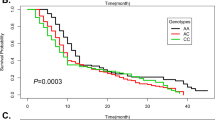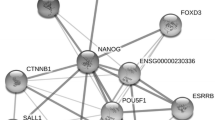Abstract
The purpose of the study was to investigate the association of single-nucleotide polymorphisms (SNPs) within excision repair cross-complementation (ERCC) gene polymorphisms, additional gene–gene interaction, and haplotype combination with osteosarcoma risk. Generalized multifactor dimensionality reduction (GMDR) was used to screen the best interaction combination among SNPs. Logistic regression was performed to investigate the association between six SNPs within ERCC gene, additional gene–gene interaction on osteosarcoma risk. Haplotype analysis was performed using SNPstats (http://bioinfo.iconcologia.net/SNPstats). Osteosarcoma risk was significantly higher in carriers with the T allele of ERCC2-rs1799793 than those with GG genotype (GT+ TT vs. GG), adjusted OR (95% CI) = 1.56 (1.13–2.01), and higher in carriers with the A allele of ERCC3-rs4150441 than those with GG genotype (GA+ AA vs. GG), adjusted OR (95% CI) = 1.63 (1.25–2.09). GMDR model indicated a significant two-locus model (p = 0.0107) involving rs1799793 and rs4150441; cross-validation consistency of the two-locus model was 9/10; and the testing accuracy was 60.11%. Participants rs1799793-GT or -TT and rs4150441-GA or -AA genotype have the highest osteosarcoma risk, compared to subjects with rs1799793-GG and rs4150441-GG genotype, OR (95% CI) = 2.87 (1.21–4.63), after covariates adjustment. Haplotype containing the rs1799793-T and rs11615-T alleles was associated with a statistically increased osteosarcoma risk, OR (95% CI) = 1.47 (1.12–1.92). We found that the T allele of ERCC2-rs1799793 and the A allele of ERCC3-rs4150441, interaction between rs1799793 and rs4150441, and haplotype containing the rs1799793T and rs11615-T alleles were all associated with increased osteosarcoma risk.

Similar content being viewed by others
References
Aiub CAF, Mazzei JL, Pinto LFR, Felzenszwalb I (2004) Participation of BER and NER pathways in the repair of DNA lesions induced at low < i> n</i>–nitrosodiethylamine concentrations. Toxicol Lett 154:133–142
Baek SK, Kim SY, Lee JJ, Kim YW, Yoon HJ, Cho KS (2006) Increased ERCC expression correlates with improved outcome of patients treated with cisplatin as an adjuvant therapy for curatively resected gastric cancer. Cancer Res Treat 38(1):19–24.
Bian Z, He Q, Wang X, Li M, Zhu L (2015) Association of genetic polymorphisms with osteosarcoma risk: a meta-analysis. Int J Clin Exp Med 8(6):8317–8328
Biason P, Hattinger CM, Innocenti F, Talamini R, Alberghini M, Scotlandi K, Zanusso C, Serra M, Toffoli G (2012) Nucleotide excision repair gene variants and association with survival in osteosarcoma patients treated with neoadjuvant chemotherapy. Pharmacogenomics J 12(6):476–483
Cao C, Zhang YM, Wang R, Sun SF, Chen ZB, Ma HY, Yu YM, Ding QL, Shu LH, Deng ZC (2011) Excision repair cross complementation group 1 polymorphisms and lung cancer risk: a meta-analysis. Chin Med J 124(14):2203–2208
Caronia D, Patiño-García A, Milne RL, Zalacain-Díez M, Pita G, Alonso MR, Moreno LT, Sierrasesumaga-Ariznabarreta L, Benítez J, González-Neira A (2009) Common variations in ERCC2 are associated with response to cisplatin chemotherapy and clinical outcome in osteosarcoma patients. Pharmacogenomics J 9(5):347–353
Hao T, Feng W, Zhang J, Sun YJ, Wang G (2012) Association of four ERCC1 and ERCC2 SNPs with survival of bone tumour patients. Asian Pac J Cancer Prev 13(8):3821–3824
Ishibashi K, Okada N, Tajima Y, Ishiguro T, Kuwabara K, Ohsawa T, Kumamoto K, Tsuji Y, Haga N, Iwama T, Ishida H, Onouchi T, Yakabi K (2011) Prediction of the efficacy of modified FOLFOX6 therapy according to the mRNA levels of thymidylate synthase (TS), excision repair cross-complementing-1 and – 2(ERCC-1 and ERCC-2) and methylenetetrahydrofolate dehydrogenase (MTHFD) in the primary lesion of colorectal cancer. Gan To Kagaku Ryoho 38(12):2220–2223.
Jin G, Wang M, Chen W, Shi W, Yin J, Gang W (2015) Single nucleotide polymorphisms of nucleotide excision repair and homologous recombination repair pathways and their role in the risk of osteosarcoma. Pak J Med Sci 31(2):269–273
Li J, Liu S, Wang W, Zhang K, Liu Z, Zhang C, Chen S, Wu S (2014) ERCC polymorphisms and prognosis of patients with osteosarcoma. Tumour Biol 35(10):10129–10136
Lu B, Li J, Gao Q, Yu W, Yang Q, Li X (2014) Laryngeal cancer risk and common single nucleotide polymorphisms in nucleotide excision repair pathway genes ercc1, ercc2, ercc3, ercc4, ercc5 and xpa. Gene 542:64–68
Ma X, Zhang Y, Sun TS, Yao JH (2016) Role of ERCC2 and ERCC3 gene polymorphisms in the development of osteosarcoma. Genet Mol Res 15(1)
Ottaviani G, Jaffe N (2009) The epidemiology of osteosarcoma. Cancer Treat Res 152:3–13
PDQ Pediatric Treatment Editorial Board (2002) Osteosarcoma and malignant fibrous histiocytoma of bone treatment (PDQ(R)): patient version.
Picci P (2007) Osteosarcoma (osteogenic sarcoma). Orphanet J Rare Dis 2:6
Qu WR, Wu J, Li R (2016) Contribution of the GSTP1 gene polymorphism to the development of osteosarcoma in a Chinese population. Genet Mol Res 15(3)
Rajaraman P, Bhatti P, Doody MM, Simon SL, Weinstock RM, Linet MS, Rosenstein M, Stovall M, Alexander BH, Preston DL, Sigurdson AJ (2008) Nucleotide excision repair polymorphisms may modify ionizing radiation-related breast cancer risk in US radiologic technologists. Int J Cancer 123(11):2713–2716
Rouissi K, Bahria IB, Bougatef K, Marrakchi R, Stambouli N, Hamdi K, Cherif M, Ben Slama MR, Sfaxi M, Othman FB, Chebil M, Elgaaied AB, Ouerhani S (2011) The effect of tobacco, XPC, ERCC2 and ERCC5 genetic variants in bladder cancer development. BMC Cancer 11:101.
Sun JM, Ahn MJ, Park MJ, Lee HY, Ahn JS, Lee S, Kang G, Han J, Son YI, Baek CH, Ahn YC, Park K (2011) Expression of excision repair cross-complementation group 1 as predictive marker for nasopharyngeal cancer treated with concurrent chemoradiotherapy. Int J Radiat Oncol Biol Phys 80(3):655–660
Yang LM, Li XH, Bao CF (2012) Glutathione s-transferase p1 and DNA polymorphisms with the response to chemotherapy and the prognosis of bone tumor. Asian Pac J Cancer Prev 13:5883–5886
Zhang HF, Yan JP, Zhuang YS, Han GQ (2015) Association between angiogenic growth factor genetic polymorphisms and the risk of osteosarcoma. Genet Mol Res 14(3):10524–10529
Acknowledgements
We thank the investigators and staffs from Yantai Yuhuangding Hospital, and all the partners and staffs who help us in the process of this study.
Author information
Authors and Affiliations
Corresponding author
Ethics declarations
Conflict of interest
There is no conflict of interest.
Rights and permissions
About this article
Cite this article
Xu, Q., Zhang, Z., Sun, W. et al. Haplotype analysis on relationship of ERCC2 and ERCC3 gene polymorphisms with osteosarcoma risk in Chinese young population. Mamm Genome 28, 227–233 (2017). https://doi.org/10.1007/s00335-017-9693-8
Received:
Accepted:
Published:
Issue Date:
DOI: https://doi.org/10.1007/s00335-017-9693-8




